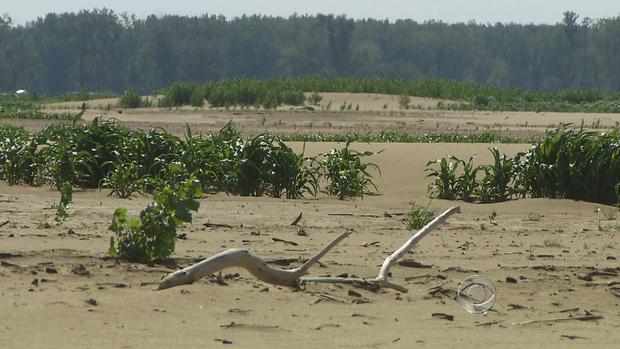Amid drought, mountains of sand from last year's flood
(CBS News) IN THE MISSOURI RIVER VALLEY - For weeks we have been reporting on the devastating drought that has gripped two-thirds of the country and is ruining farm crops. Eighty-seven percent of the High Plains is now in drought, compared to 15 percent last year. And in one area, farmers have yet another problem: they're still dealing with the effects of floods that swept through the area a year ago.
Scott Olsen's family has been farming in the Missouri River Valley for three generations. Last summer, floods washed away his crops -- and those of nearly 500 other farms along the Nebraska-Iowa border. The floodwaters left behind a sea of sand.
"Just total waste, that's all there is to it," Olsen said.
The sand came from the rising Missouri, which broke through the levees with currents so strong it swept the sand out of the riverbeds. It settled onto 400,000 acres of prime farmland. Olsen says it will take years before his soil is back to normal.
"I figure on the ground I got, last year, I lost about a half million dollars on that piece of land," he said. "And I'll probably have half a crop this year."
"It's just not me," he added. "It's many other people with the same problem."
That includes Mason Hansen. His farm is 70 miles downriver and was one of the worst hit. He has spent the last 10 months trying to clear thousands of pounds of sand off his land. His biggest challenge: a four-foot-high wall of sand that spans 90 acres.
The fine, beach-like sand is everywhere, and, Hansen says, "it raises nothing."
Farmers have been using tractors and bulldozers to push the sand off the cropland. But environmental regulations prohibit them from dumping it back in the river, because it has now been exposed to chemicals used to treat farmland.
Hansen says he'll take the top two feet and bulldoze it into pits left by the floods. The rest he says he'll mix in with the soil underneath -- and hope he can replant.
Olsen has spent the last year surveying the devastation from the air, taking pictures to help his neighbors assess the damage.
"It's just a very tough situation, very tough," he said. "And we will lose some farmers out of this."
Emotion runs deep in these communities, Olsen said -- "just like the water did."
The federal government has set aside $20 million to help clean up America's heartland. But farmers say that won't even cover half their costs.

